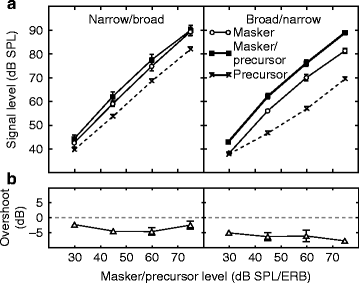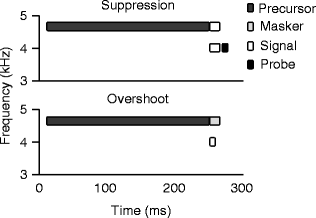Fig. 8.1
Average signal detection thresholds for five participants as a function of the masker/precursor level (a). The open circles show the thresholds for the masker alone, the filled squares show the thresholds for the masker plus precursor and the crosses and dashed lines show the thresholds for the precursor alone (see legend in rightmost panel). Different stimulus conditions are shown in different panels (see panel titles). The amount of overshoot (i.e. the threshold difference between the masker-alone and masker-plus-precursor conditions) for each condition is shown in the lower panels (b). Error bars show the standard error of the mean (SE)
These results are consistent with previous findings. The amount of overshoot found in the broad/broad and notch/notch conditions was slightly smaller, but generally comparable to the amount of overshoot found in previous studies under similar stimulus conditions (von Klitzing and Kohlrausch 1994; Strickland 2001, 2004). Our results indicate that off-frequency energy in the masker and precursor is required for overshoot to be measurable. This is consistent with the results of Bacon and Smith (1991). The negative overshoot in the narrow/narrow condition can be interpreted in several ways. On the one hand, it might mean that no overshoot occurred in this condition. The signal-to-masker ratio was slightly smaller in the narrow/narrow than broad/broad condition and may have been too small for overshoot to be effective. On the other hand, it may be that overshoot occurred, but the effect was countered by other factors. In particular, the signal may have been detected in frequency channels remote from the signal frequency (“off-frequency listening”; Patterson and Nimmo-Smith 1980) to which overshoot would not be expected to apply. Alternatively, any overshoot effect in the narrow/narrow condition may have been overridden by additional masking produced by the precursor; the precursor produced relatively more forward masking in the narrow/narrow condition than in either of the other two conditions. In order to test these possibilities, we measured overshoot in two further conditions.
In the first condition, referred to as “narrow/broad”, the masker was broadband as in the broad/broad condition, but the precursor was narrowband as in the narrow/narrow condition. This condition was expected to yield only on-frequency overshoot (due to the precursor being narrowband) while removing the possibility of off-frequency listening and also increasing the signal-to-masker ratio. In the second condition, referred to as “broad/narrow”, the masker was narrowband and the precursor was broadband. This condition was intended to reduce forward masking by the precursor and thereby prevent the masking from overriding any overshoot effect. The broadband precursor might also elicit stronger MOC activation (Lilaonitkul and Guinan 2009) and thus cause more overshoot.
Figure 8.2 shows that both conditions yielded significant negative overshoot [narrow/broad:−3.3 dB; F(1.0,4.0) = 63.94, p = 0.001; broad/narrow: −6.1 dB; F(1.0,4.0) = 73.42, p = 0.001].


Fig. 8.2
Average signal detection thresholds (a) and overshoot (b) for the narrow/broad (left panels) and broad/narrow (right panels) conditions, plotted as in Fig. 8.1
The absence of positive overshoot in the narrow/broad condition (Fig. 8.2, left panels) precludes the possibility that the absence of positive overshoot in the narrow/narrow condition was due to off-frequency listening or too low a signal-to-masker ratio. As in the narrow/narrow condition, the negative overshoot in the narrow/broad condition may have been due to the additional masking caused by the precursor. However, additional masking by the precursor cannot explain the absence of positive overshoot in the broad/narrow condition (Fig. 8.2, right panels). The broadband precursor in the broad/narrow condition produced less masking than the narrowband precursor in both the narrow/narrow and narrow/broad conditions, yet the amount of negative overshoot was greater (−6.1 dB versus −1.8 and −3.3 dB; p = 0.002 and 0.059). It is possible that the negative overshoot observed in the broad/narrow condition was due to informational (“transient”) masking (Bacon and Moore 1987), which would be assumed to arise at central rather than peripheral processing levels.
Taken together, the results from Experiment 1 indicate that both the masker and precursor must contain off-frequency energy for measurable positive overshoot to occur; conditions in which the masker and/or precursor are limited to on-frequency channels yield either no or negative overshoot. The aim of Experiment 2 was to test whether overshoot in off-frequency conditions is caused by MOC-mediated reduction in cochlear gain.
3 Experiment 2
According to the gain reduction model, overshoot in off-frequency conditions is due to reduction in suppressive masking. Suppressive masking occurs when the masker and signal are presented simultaneously and is maximal when the masker is above the signal in frequency. In contrast to excitatory masking, suppressive masking occurs, not through “swamping” of the signal response by the masker response, but by a masker-induced reduction in the size of the signal response. Houtgast (1972) showed that the degree of suppression of the signal response can be measured by measuring the amount of masking that the signal exerts on a subsequent probe stimulus. In this experiment, we used Houtgast’s method to estimate the reduction in suppressive masking brought about by the precursor in an overshoot paradigm where the masker and precursor are above the signal in frequency. Previous work has shown that such paradigms tend to yield large overshoot (Bacon and Viemeister 1985).




